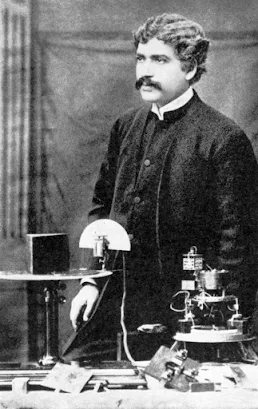J.C. BOSE-THE MAN WHO GAVE PLANTS LIFE!
Every great scientist ever born is known for their outrageous, out of the box scientific developments. When the whole world looked otherwise, these men with their cunning understanding of the laws of nature shook the basic foundations of science once and for all.
This calls for Acharya Jagadish Chandra Bose or J.C. Bose from the Indian subcontinent under the British Empire.
J.C. Bose was a physicist, working with microwaves and means of wireless communications. He was the first man to successfully communicate over wireless telegraphy from the Presidency College of Calcutta to a nearby institution. He was also successful in igniting a lump of gunpowder using microwaves in the Town hall. But his works on plant neurobiology made him one of the greatest scientists of all time.
During the late 19th century nobody thought that plants are living beings like animals or humans, let alone prove or believe. More myriad was the living nature of metals. But J.C Bose showed that metals undergo fatigue and plants can feel emotions just like us. There was an initial uproar in the scientific community about his discoveries but later everyone had to accept all his theories, without a single question.
 |
| Agence de presse Meurisse / Public domain |
Early life: J.C. Bose was born on 30th November, 1858, in present day Bangladesh. His father Bhagavan Chandra Bose and mother Bamasundari Devi with their tireless efforts and sacrifice paved the way for the greatness of their son.
Being born under the British Indian empire, Bose started his childhood education in a local vernacular school. He later got admitted to the Hare School, and the St. Xavier's for English education. Later he journeyed towards London to study medicine. But because of weak health and suffering from health problems due to human-body dissection he decided to pursue a career in physics. He got into Cambridge University to study physics, chemistry and plant biology. Renowned scientists like Francis Darwin, Lord Rayleigh and others greatly influenced this young man from India. In time, he earned a Tripos in natural science and a B.Sc from London University.
Just Before His Work with Plants: Before his revolutionary work with plants, he discovered a weird phenomenon. While working with different machines for developing wireless telegraphy, he found his instruments behaving in a weird way. Operating them for hours, without break made them quite unresponsive for some moments. On giving a break they performed fine. Thus accidentally he stumbled upon something called ''metal fatigue''. And from this metal fatigue he came up with the idea of tiredness in intermediate life forms like plants.
When Plants Came Alive! Finally, J.C.Bose unfolded the domain of plants and their living nature to the scientific community and to all mankind. Here's the points.
- During a lecture in the Royal Society, he proposed that unlike living beings like humans and animals, non-living objects such as different materials, metals and instruments can show a similar type of responsiveness. Thus plants, the intermediate of living and non-living, must show some form of response to external stimulus. Burdon Sanderson who spent his whole life studying plant physiology contradicted him. Sanderson said that certain plants like mimosa pudica can react to external stimuli, but not all. Neither can all plants give electro-chemical response.
- J.C Bose invented the Resonant Recorder; a machine that could detect the feeble response of plants. The plants showed heightened responses when subject to electrical shock, and external pains like root decapitation, shoot decapitation, acid attack, poison gas attack and others. Touch-Me-Not plant or Mimosa pudica responded vigorously on being pinched.
- After 1917, he invented the Crescograph, a device to measure the growth of plants. Plants grow extremely slowly, only about a millionth parts of an inch. When the plant was stimulated it got a nervous shock and its growth was halted for a period of 30 mins, and resumed again.
- Bose could literally converse with plants. While recording a particular plant's response he noticed a brief moment of non-responsiveness. Later he concluded that the dip was due to the obscurity of sun-light by a patch of cloud. He also said that humans aren't capable of detecting these minute changes in their environment, but plants can. Thus it was again proved that plants are living beings just like us.
 |
| source: Biswarup Ganguly / CC BY |
 |
| The Birth Centenary Committee, printed by P.C. Ray / Public domain |
The Plant Whisperer: J.C Bose was a man ahead of his time, just like all great men. He was a true scientist, and a man who dared to venture out into the roughest waters without having the fear of losing sight of the shore. At first no one believed his controversial ideas about the living nature of plants. But fortunately, nothing could stop the man who was born to convey the story of a plant's life to the whole world.
He became a plant whisperer. And all those plants perhaps chose him to be someone with whom they could share their tiny secrets. J.C Bose even went to the extent of proving that plants have a feeling too. Why do we feel emotions? It's because our body releases electro-chemical signals and a bunch of hormones in response to some external stimulus. Plants can do that too. If we hurt a plant it feels pain. If we give them alcohol, well...you know the same happens to them. A plant's feelings are much different from ours, but that doesn't mean they don't feel anything. Animal bodies possess a network of neurons, and plants have electro-chemical responses. Thus if we pinch a part of mimosa pudica, another completely untouched part reacts to the pinching apart from the region of stimuli. These processes were magnified in the Resonant Recorder, thereby proving once and for all that plants are living beings just like us.
References:
- https://en.wikipedia.org/wiki/Jagadish_Chandra_Bose
- https://www.britannica.com/biography/Jagadish-Chandra-Bose


Comments
Post a Comment